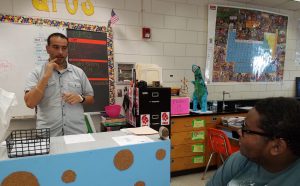An interpreter can bridge two differing realms of communication together. On campus, Emmanuel Mendoza helps ensure the deaf and hearing communities are not divided, but rather intertwined.
“My favorite thing as a sign language interpreter is that I am able to connect two different worlds: deaf culture with hearing culture. That is the coolest thing,” Mendoza, interpreter, said.
At 8 years old, Mendoza’s curiosity for sign language sparked after his encounter with a deaf girl.
“The girl was mean to me but I wanted to know what she saying. I’d ask the interpreter what she said and she would say you don’t want to know,” Mendoza said.
Determined to understand the girl’s signing, Mendoza asked the interpreter to teach him a couple of signs a day. His expanding knowledge did not go unnoticed by his teacher. One day, in the interpreter’s absence, Mendoza’s teacher asked him to help the deaf girl with her homework.
“I tried [signing the homework lesson to her] and after that she was nice to me. Then I met all the other deaf kids in school,” Mendoza said.
Soon after, Mendoza befriended a group of deaf students at his school, often inviting them to his house to play volleyball.
“[Befriending the deaf kids] opened my life to new experiences. Being a part of their world made me see the world in a different way,” Mendoza said.
This new view of the world inspired Mendoza to pursue his career in interpreting. His first job signing at a doctor’s appointment, showed Mendoza that interpreting takes more than a general understanding of the language.
“My first experience was bad. [The doctors] were telling me everything and I was like ‘Uh huh, Uh huh’, but when the deaf person asked me what happened I [just said] ‘Oh, you’re sick’,” Mendoza said.
After his bad experience, Mendoza went to Valencia College to get a certification in American Sign Language.
Signing for 25 years, and 11 years on campus, Mendoza continues to embrace the culture of sign language.
“[Throughout my years here], the department has improved a lot. Everyone is more aware [of the deaf culture]. The teachers are aware of interpreters now and the hearing kids understand what is going on. Ten years ago they would watch you the whole time instead of paying attention to the class, but now not so much,” Mendoza said.
Through the work of interpreters like Mendoza, the bridge between the hearing and deaf culture continues to strengthen.

